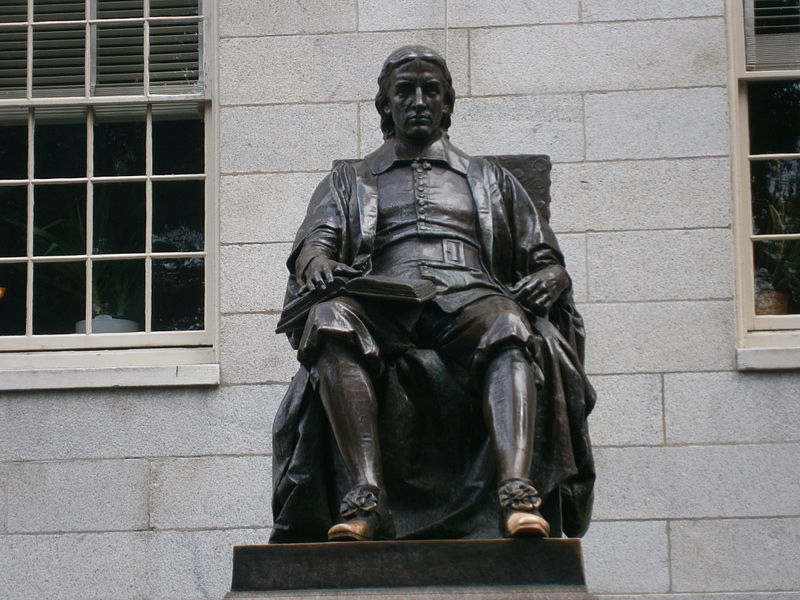On September 9th, Harvard President Larry Bacow provided an update on how the university is addressing climate change, including in its investment portfolio. In a letter sent to all students, faculty, and alumni, he characterized the issue as "the most consequential threat facing humanity" and briefly summarized three main fronts on which the university is engaging with the problem: investments, research and teaching, and on-campus sustainability practices. If one reads through his letter quickly, it's easy to conclude that the university is effectively divesting from fossil fuels.
Indeed, much of the press coverage on the letter has framed Bacow's statement as de facto divestment even though that word was never actually used. Here's a sampling of headlines: from the Washington Post: "Harvard, America’s richest university, will divest from fossil fuels"; the New York Times: "Harvard Says It Will Not Invest in Fossil Fuels"; the Harvard Crimson: "Harvard Will Move to Divest its Endowment from Fossil Fuels"; The Hill: "Harvard announces divestment from fossil fuels".
Directionally, it's important to recognize that Bacow's letter is a positive step in decarbonizing the portfolio; and further, that this step likely would have taken much longer to achieve had there not been intense and sustained engagement on the issue by faculty across most Harvard schools, generations of students, and many prominent alumni. His letter is a formal, top-level statement that the University plans to steer clear of new investments in fossil fuel extraction, and not just in public companies but in its private equity portfolio as well. Importantly, Bacow also highlights an already growing effort by Harvard Management Company to invest in climate solutions, and indicates this will be a long-term focus in the portfolio.
Bacow's letter also includes interesting language on investments in fossil fuel extraction and aligning investment decisions with the university mission: "Given the need to decarbonize the economy and our responsibility as fiduciaries to make long-term investment decisions that support our teaching and research mission, we do not believe such investments are prudent." People with whom I've spoken view this phrasing as a response, and perhaps a parry, to a recent complaint brought by a variety of Harvard stakeholder groups to the Massachusetts Attorney General. This complaint argued that fossil fuel investments violated Harvard's original charter from the state (general descriptions of the complaint and its history here and here).
Unfortunately, as has also been the case with earlier statements and reports by both the University and Harvard Management Company, there's some finessing of language going on as well. Those missing details matter a great deal in terms of how much pressure Harvard administrators and portfolio managers feel to move expeditiously towards decarbonization, how quickly shortfalls will be discovered, and what leverage others have to encourage mid-course corrections. Absent additional statements or actions, these omissions mean that the speed of investment restructuring will be slower, and the breadth narrower, than President Bacow's letter implies.
The remainder of this post goes through the specific wording of the letter, highlighting places where that language creates likely gaps in the decarbonization process.
Parsing President Bacow's letter on fossil fuel investment
Here are some of President Bacow's specific points, followed by my thoughts:
1) Commitments are informal statements of intent, without binding language and interim deadlines
President Bacow: As we reported last February, HMC has no direct investments in companies that explore for or develop further reserves of fossil fuels. Moreover, HMC does not intend to make such investments in the future.
- Private equity is clearly placed within the school's domain of action. Harvard has very few direct investments in publicly-traded companies in any industry, and within that subset (which is reported quarterly to the SEC), we've known for some time that there are no upstream fossil fuel companies. What is potentially new is the implication that even directly-held upstream producers that are not publicly traded will be excluded from investment, which is an improvement.
- Letter includes commitments and promises, but nothing binding. While the indication that HMC does not "intend" to make such investments in the future is potentially promising, there are no formal restrictions on what they can and can't do. The investment team continues to have wide discretion to change their investment focus at will. Further, based on current levels of investment disclosure, unless Bacow or HMC told us, we'd never know their intent had changed. In contrast, Columbia University has formalized exclusions, and has also included a broader array of fossil fuel activities as subject to their new investment guidelines.
- Interim deadlines and timelines have still not been released. Aside from a 2050 net zero target, Harvard does not have a timeline by which to exit key fossil fuel-related sectors. It needs one. Georgetown University, for example, set a five year exit window for publicly-traded investments and a ten year exit window for privately-held firms.
2) Included sectors are narrowly cast; many large and important economic sectors, investment vehicles, and asset types appear to remain outside of Bacow's statement
The exclusionary language in Bacow's letter includes only "companies that explore for or develop further reserves of fossil fuels." Up-stream development of new coal, oil, and natural gas reserves is very much an activity that will contribute significantly to future atmospheric loadings of greenhouse gases, so excluding them is beneficial -- particularly if copied by other large institutions. However, Bacow's framing follows the carefully crafted language in HMC's first Climate Report earlier this year, which left out a great deal. As I noted in my review of the Climate Report:
So, what does this narrow definition leave as an allowable investment, untouched and unreported? Apparently:
- These exact types of firms, if held in commingled portfolios such as mutual funds, ETFs, or more diversified private equity, venture, or hedge funds (i.e., investments not "held through dedicated externally managed funds").
- Other portions of the fuel cycle, such as pipelines, storage, refineries, compression stations, export terminals, or LNG or oil tankers.
- Fossil-intensive industries, including not just energy-intensive industries like cement, but also natural-gas and coal-fired power plants.
- And it even seems to leave in firms that are working their existing reserves of fossil fuels, so long as they are not developing new ones.
All of these issues remain today.
3) Roll-off period of private equity will be longer, though is not a concern to me; what is a concern are all of the other asset classes that seem to be ignored
President Bacow: HMC has legacy investments as a limited partner in a number of private equity funds with holdings in the fossil fuel industry. These indirect investments constitute less than two percent of the endowment, a number that continues to decline. HMC has not made any new commitments to these limited partnerships since 2019 and has no intention to do so going forward. These legacy investments are in runoff mode and will end as these partnerships are liquidated.
- A slower roll-off of private equity fossil fuel holdings is common across many universities; the actual pace could be faster than expected. The intention to make no new capital commitments to fossil fuel extraction via private equity partnerships is a notable improvement from past statements. Bacow notes that Harvard's fossil fuel exposure in this asset class will run off over a period of years, which is to be expected given the structure of these vehicles. Harvard's annual Financial Report lists the remaining duration of its private equity funds of between 2 and 10 years, so this could take a while. However, I see this as an area where things may end up better than expected in terms of timing. Because there is a secondary market even for private equity portfolios, it is very possible that HMC will be able to exit the most problematic of these positions on reasonable terms by selling them to other parties, and could implement these sales well before the funds wind down on their own. The University's past holdings in farmland are illustrative: through sales and spinoffs, HMC CEO Narv Narkemar cut the natural resources share of Harvard's portfolio from 9% in December 2016 when Narkemar arrived to 2.6% in June 2020.
- More problematic is the lack of clarity on other asset classes within Harvard's portfolio. As of June 2020, the portfolio was allocated 23% to private equity. Bacow says less than 2 percent of this is related to fossil fuels, though based on my review of past HMC statements, this could refer to the share of all private equity holdings period, or just to the share of energy-focused funds (ignoring more mixed funds that may also contain some oil and gas). It likely excludes fossil fuel investments outside of upstream extraction. On the public equity side, the FY 2020 Financial Report notes publicly traded stocks are 19% of the portfolio, but we know from 13F filings with the SEC that less than 2% of the endowment is in the form of directly-held stocks or exchange traded funds. Public equities outside of the SEC filings may or may not be getting counted in Bacow's statements; if they are not, it implies that as little as a quarter of the portfolio (23% private equity plus 2% directly held, SEC-reported public equities) is directly covered by Bacow's divestment statements -- with the remainder in investment vehicles that are harder to track..
Could Bacow and HMC be including more of the portfolio in their forward-looking commitments to exit fossil fuels? It is possible. But absent clearer statements and must better disclosure of holdings, one should be wary about the breadth of what is being culled. Many other endowment and pension funds already do much better disclosure of holdings in every asset class than Harvard does now or has committed to in the future. Harvard needs to improve greatly in this area.
- Hedge funds will be a particular challenge. Indications from the university are that even the investors within many hedge funds have little visibility on the underlying holdings. Further, these holdings can change rapidly over time such that company- and sector-exposures at the end of a reporting period (when investors have some visibility on holdings) may be quite different from what the fund held in the middle of a reporting period. Since hedge is the single largest asset class in the portfolio as of the 2020 Financial Report (36.4%), the inability to track and report the carbon impacts or even sectoral holdings within hedge investments is a big problem.
4) Green investment is great, but not all that claims to be green really is; transparency on holdings even for climate positive investments is needed
President Bacow: HMC is building a portfolio of investments in funds that support the transition to a green economy. In addition, the University has made investments alongside MIT in The Engine, a fund that, among other things, seeks to accelerate the development of technologies that promise to address the challenges posed by climate change.
- Hunting strong investment options in decarbonization both alone and with MIT is a good strategy. The investment in firms involved with greening the economy is a plus, as is the partnership with MIT in identifying and funding some of these initiatives. While MIT and Harvard routinely compete with each other, pooling efforts to identify and fund some of these areas should be beneficial to all.
- But external transparency is needed if claims of progress are to be trusted. In the same way that disclosing HMC's company-level investments is needed to evaluate whether they are decarbonizing the portfolio in an effective and timely manner, so too is that disclosure needed on the "green" initiatives. Too many investments claiming to be green end up being mostly greenwashing and move the needle little or not at all on decarbonization. While sometimes this is the result of deception by investment promoters, it need not be purposefully misleading to be a problem for Harvard achieving its 2050 net zero goal. For example, some vehicles are trying to fund the "green" portion of a very polluting company overall (e.g., with many green bonds); or an idea seems intriguing until it is scaled to displace existing practices at which point the environmental problems of the "solution" become impossible to ignore (corn ethanol, for example). In other cases, the initiatives may be well meaning but ineffective -- with little chance to grow at scale within the time frame needed to stabilize atmospheric carbon. I would put most new nuclear technologies into this camp (though obviously others, including The Engine run by MIT, disagree). And in others, they are game changing and warrant much larger allocations of capital.
Obviously HMC will try to separate these categories itself. But it's staff is small, the vetting is not easy, and external visibility of the decisions made on both decarbonization and green companies is needed to tighten and improve the decisions made over time. These disclosures can be made with a delay of 12-18 months to protect HMC's competitive strategy, but they do need to be made.
5) Committing to net zero by 2050 is merely a talking point if not supported by staff, timelines, and transparency
President Bacow: HMC was the first endowment in the country to commit to achieving net-zero greenhouse gas emissions across the entire investment portfolio by 2050.
- Harvard still lacks formal milestones and adequate disclosure. This is a great target, but at present lacks interim milestones, a team large enough to carry it out, and virtually any disclosure of investment holdings. The school is also working to develop it's own brand new method to measure the carbon footprint of these firms. To the extent this measurement holy grail becomes the enemy of the many, many things Harvard can do with much cruder information, we are in trouble.
- Much more on the limitations in Harvard's current net zero approach and how to address them in this publication.
Earth Track's Earlier Work on Decarbonizing Harvard's Portfolio
Investment Disclosures by Asset Class: Current Practice at Harvard Compared to Other Large Funds (July 2021)
Decarbonizing Harvard’s Endowment: Reviewing Harvard Management Company’s First Climate Report (May 2021)
Reducing the Carbon Footprint of Harvard’s Endowment: A Review of Information Gaps and Potential Leverage Points (September 2019)





